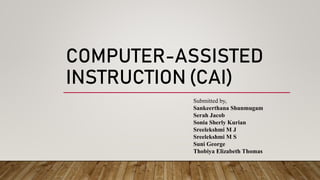
CAI.pptx
- 1. COMPUTER-ASSISTED INSTRUCTION (CAI) Submitted by, Sankeerthana Shunmugam Serah Jacob Sonia Sherly Kurian Sreelekshmi M J Sreelekshmi M S Suni George Thobiya Elizabeth Thomas
- 2. COMPUTER-ASSISTED INSTRUCTION (CAI) • Computer has contributed a lot in each and every sector of life. • CAI has emerged as an effective and efficient medium of instruction in the advanced countries of the world. • Computer are being used in almost all areas of life such as transportation, communication, scientific research, and education. • The first commercial computer became operative in 1951 in the U.S Census Bureau. • First CAI was made around 1961 when the University of Illinois produced Programme Logic for Automatic Teaching Operation.
- 3. CONCEPT • CAI is an interactive instructional technique whereby a computer is used to present the instructional material and monitor the learning that takes place. • It is a method of instruction in which there is a purposeful interaction between a learner and the computer (having useful instructional material as software).
- 4. • The computer contains a stored instructional program designed to inform, guide, control, and test the student until a prescribed level of proficiency is reached. • The method of communication is customarily based on a stimulus-response-feedback signal flow.
- 5. •It uses a combination of text, graphics, sound, and video in enhancing the learning process. •Also, typical CAI provides/does: 1. Text or multimedia content 2. Multiple-choice questions 3. Problems 4. Immediate feedback 5. Notes on incorrect responses 6. Summarize students' performance 7. Exercises for practice 8. Worksheets and tests.
- 6. DEFINITION CAI is an interaction between a student, a computer controlled display, and a response entry device for the purpose of achieving educational outcomes.
- 7. TYPES OF CAI 1. Inquiry mode/Informational CAI: In this CAI, system responds to student’s inquiry with answers it has stored. Learner gets the desired information. This provides minimal interaction between the computer and the learner. 2. Drill or Practice: In this mode, the program leads the learner through a series of examples to develop dexterity and fluency in using the skill. All correct responses are reinforced.
- 8. 3. Tutorial mode: In tutorial, information is presented in small units followed by a question. The pupil’s response is analysed by the computer and appropriate feedback is given. The pupils are allowed to work at their own pace. 4.Gaming mode/educational games: Here, the learner is provided with a variety of well-designed computer games to provide intellectual challenge, stimulation of curiosity, and to motivate the individual learner. This mode may or may not be instructional, but it is recreational. This mode is especially meant for young children.
- 9. 5. Simulation Mode – In this mode, with carefully prepared programmes students are made to face real or idealized situations which would provide training for the students. Such types of instructional activities are powerful learning tools in which the students have an active role and have to take proper decisions. It is less expensive and less dangerous. 6.Problem Solving Type CAI (Discovery Mode) – Here, the process of finding the answer to a problem is given more importance than the answer itself. Such CAI programmes make them think about the ways and means of solving the problem systematically.
- 10. 7.Practical Work-Oriented Instruction – CAI programmes can be used to supplement laboratory and other practical work. A student can learn about science experiments before actually performing the experiment or about those experiments that are dangerous to be performed in a laboratory.
- 11. SCOPES OF CAI • CAI allows every student to move at their own speed. In classroom, the teachers will be too fast or too slow for students. In either case, the students will lose interest. CAI can eliminate this problem. It allows students to study any subject any time they wish. The normal school with a fixed timetable does not give this freedom. The computer also gives special attention to each student, keeps tracks of his or her difficulties, and is extremely patient.
- 12. Apart from teaching subjects like mathematics, CAI can also be used for science experiments without the student going to a laboratory. In one such lesson, the screen shows all the items of apparatus needed for an experiment. The student has to first assemble the items correctly and make the set-up on the screen.
- 13. She does this by touching an item on the screen and then touching that part of the screen to which she wants the item to be moved. The screen is sensitive to touch and the computer shifts the items on the screen as desired. The screen shows the experiment in progress. If all goes well, it also shows the results.
- 14. • Thus, the student learns all about the experiment--- what to do and what not to do. • The student can be involved in dangerous / hazardous tasks without any risk. • Experiments that may take years can be shown in a few minutes.
- 15. • CAI is particularly good for subjects like arithmetic, languages, and computer programming. In one experiment, a computer was very successful in teaching three-year-old children the basic skills of reading and writing. • Even differently abled children did well in the computerized classroom.
- 16. ADVANTAGES OF CAI • One-to-one interaction • Individual attention • Instantaneous response or immediate feedback • Self pacing---it allows students to proceed at their own pace • Privacy helps shy and slow learner to learn • Teacher can devote more time to individual students • Multimedia helps to understand difficult concepts through multisensory approach.
- 17. LIMITATIONS •The computer fails to appreciate the emotions of students •CAI fails to develop essential features of language competency •A sort of mechanical approach to education
- 18. • Some students get more tired in CAI than conventional study • Servicing of hardware causes problems • Highly expensive and uneconomical • Use of internet may lead to cyber sloth and plagiarism